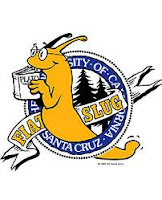 There are two wikipedia pages with information on mascots: one lists each type of mascot (i.e., bobcat) and all the schools that use that mascot (no fewer than 15 colleges and universities claim the bobcat as their mascot); the other has an alphabetical listing of all of the names of the mascots and their schools (i.e., Cayenne — a costumed chili pepper for the Ragin' Cajuns of Louisiana-Lafayette). I had to look up Cayenne (at right) to see what a costumed chili pepper looked like, and he is quite
There are two wikipedia pages with information on mascots: one lists each type of mascot (i.e., bobcat) and all the schools that use that mascot (no fewer than 15 colleges and universities claim the bobcat as their mascot); the other has an alphabetical listing of all of the names of the mascots and their schools (i.e., Cayenne — a costumed chili pepper for the Ragin' Cajuns of Louisiana-Lafayette). I had to look up Cayenne (at right) to see what a costumed chili pepper looked like, and he is quite Some of the mascots make sense in a very old-fashioned way. Jamestown athletes are known as the "Jimmies," student athletes at St. John's in Minnesota are known as the "Johnnies," and their brethren at St. Thomas (MN) are known as the "Tommies."
 You gotta love the UC schools, who clearly went out of their way to select mascot animals that no one else wanted. UC-Santa Cruz went with the Banana Slugs, while UC-Irvine is the Anteaters. The slug is damn cute--at least this drawn version (left). The mascot version (right) is a little stranger. Another interesting mascot from the west coast is the Geoduck (pronounced "Gooey Duck") from Evergreen State. (I wouldn't know what a geoduck is if I hadn't been watching the last season of Chopped; it was one ingredient in the basket.)
You gotta love the UC schools, who clearly went out of their way to select mascot animals that no one else wanted. UC-Santa Cruz went with the Banana Slugs, while UC-Irvine is the Anteaters. The slug is damn cute--at least this drawn version (left). The mascot version (right) is a little stranger. Another interesting mascot from the west coast is the Geoduck (pronounced "Gooey Duck") from Evergreen State. (I wouldn't know what a geoduck is if I hadn't been watching the last season of Chopped; it was one ingredient in the basket.) Some mascots are not what I would imagine when I thought of the school. I was surprised to see that Trinity Christian College chose the "Troll" (left) as their mascot. Seems an odd choice. He is kinda wild looking, in a Saturday morning cartoon kind of way.
Not to be outdone, the students of Webster created their own mythic mascot: a Gorlok (below). According to Wikipedia, "The Gorlok is Webster University's school mascot. It is a mythical creature that was designed by Webster staff and students through a school contest. It has the paws of a cheetah, the horns of a buffalo, and the face of a Saint Bernard dog." Lest you wonder what such a creature would look like, I have added a picture below. (The in-person mascot looks a lot more cat-like.) Too much Star Trek for the students of Webster, hmm? ("The Gorloks are attacking, captain!" "Set phasers to stun!") I have to say, between the Troll and the Gorlok, I would be shooting for the Troll.
In this day of student athlete arrests, it is somewhat foreboding to name your team the Vandals (Idaho), Bombers (Ithaca), Chokers (Grays Harbor College), and Dirtbags (Long Island State baseball). I find it ironic that only one school claimed its athletes to be Gentlemen--the men's teams from Centenary--and they changed their mascot in 2007 to the Louisiana Catahoula--a very cute dog. Their women, of course, were the "Ladies," though they share that (previous) title with the women athletes at Kenyon College (whose men were more impressively named "Lords").
The real question, of course, is: Does the mascot name bear any relationship to how well a team does in the Big Dance? You can read through the list of championship teams and play a 2-player version of rock-paper-scissors, comparing the scariness of the mascots for each team to see if that justifies the win. For example, last year's champs, the Blue Devils, do seem more threatening than the Butler Bulldogs, with the supernatural angle and all. Clearly, alligators would maul a buckeye (
I would encourage you to review your brackets and see which threatening and/or impressive team mascot should win the game. Hey, you can't do any worse than my current brackets!






